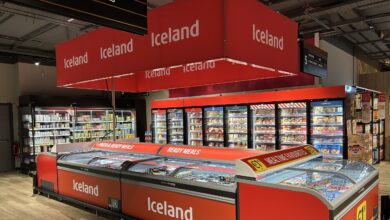Video game retailing has come a long way
While Tesco will cease selling boxed video games once its stock runs out, Game vowed to be ‘the last man standing’ in physical video game retail. As almost 90% of people purchase games online, retailers will have to get creative to attract interest

Register to get 1 free article
Reveal the article below by registering for our email newsletter.
Want unlimited access? View Plans
Already have an account? Sign in
During the pandemic, Game closed approximately 40 of its UK regional branches, while this year, it made the decision to close all of its 35 stores in Ireland to relocate concessions in Sports Direct outlets. However, the new CEO of Game, Nick Arran, vowed that the specialist games retailer will be “the last man standing” in physical video game retail.
This is in spite of the digital entertainment and retail association (ERA) reporting that 89.5% of games sold in 2022 have been digitally downloaded, with only the remaining 10.5% actually making up physical copies sold.
The ERA reported that roughly 30% of these video game sales came from mobile apps, which are sold digitally. Data gathered by the ERA also showed that gamers are also much more likely to download games through consoles or PC, rather than wait for a delivery or to go to a shop.
Luke Fisher, group account director of gaming at creative agency 20ten, is unsurprised by the buying habits of games. He says: “There’s been a real rise in the digital focus for game distribution. From our experience working with developers and publishers and platforms, over the past 10 years the budgets that exist for physical POS have followed a continual downward trend year-on-year.
“I think that’s mainly driven by the fact that game developers’ digital media stores have been hoovering up all of those direct downloads, which has just cannibalised demand for physical games retail.”
While the ERA reported that the gaming industry accounted for £4.7bn worth of UK sales in 2022, digital stores owned by game platforms do not have to publish their sales figures.
Kim Bayley, ERA chief executive, says: “While growth at 2.3% was lower than that of video or music, its scale is enormous – and in terms of innovation and excitement, it continues to set the pace for the entire entertainment sector. In the old days, when there was pretty much only physical console games and PC discs, it was far easier to track the market.”
“These days, it’s a lot more fragmented and sometimes the new digital players simply won’t share their sales data directly – that’s where estimates come in. The proof of the pudding is how the numbers are received and respected,” she adds.
Unlike Game, Tesco revealed in mid-July of this year that once its current stock of physical video games have been sold, it will no longer stock them in its estate of over 2,800 stores. The supermarket chain reported its reasons for this decision to be linked to all of its customers moving towards digital entertainment, and as a result, will abandon all but selling currency cards that can be used to purchase digital games from online marketplaces like the PlayStation Store.
Fisher is “fairly confident” that, for a while, a lot of supermarkets have been taking gaming on as a loss-leader “just to get people into stores”. Only, he believes that has backfired somewhat, since “people just aren’t buying anymore”.
That said, he maintains that boxed video games will always have a place in brick-and-mortar retailers, because they offer something that online stores can’t.
“‘In Real Life’ innovations have to tell the story of the product they are trying to sell. Retailers like Game are able to partner with video game platforms to organise full store takeovers that grab people’s attention. This really helps that retail proposition,” Fisher says. “You can’t really do that online in the same way, that’s also the nice thing about game stores. Store takeovers happen for big titles – like God of War or Final Fantasy XVI, for example – and they decorate the store with banners, full shelves of the game, floor stickers, and digital screens at the front that display in-game content.”
Fisher also noticed that, whereas 10 years ago the big focus had been on showcasing the software and mechanics behind a new game in stores, the focus has now shifted to physical merchandise and collectibles – posters and toys like Funko Pops – all of which Fisher says are “getting prominent retail space”.
He goes on to explain why physical retail spaces will still be important among collectors of game memorabilia: “When buying a game online, you know what you’re getting – a copy of the game that you can download. But when you’re buying a limited edition copy that comes with an alloy statue and an artbook [of the game], being able to see those in real life is important for consumers. Online you can’t really put together what exactly it is that you are buying.”
Merchandise is clearly one way for retailers to capitalise on video game-related product demand among consumers, but Fisher believes purchasable game currency is also an important part of the brick-and-mortar experience.
“Top-ups allow people to buy titles, but then you start to realise that each individual game has its own form of in-game currency for purchase and that can get confusing if you are buying a present for a niece or nephew without knowing a lot about the game they play,” he explains. “I’m thinking there must be a way for retailers to offer more help to demystify those gift card panels and make it more user-friendly for the people who aren’t actually playing the game.”
The current way gamers purchase games has been dramatically changed by the behaviour of video game distributors. Many of them – such as EA, Valve and Activision-Blizzard – have set up their own online platforms to promote and sell their titles. Quite a few parallels could also be drawn between the gaming landscape and the age of film and tv streaming.
With that said, Fisher believes retailers could do a number of things in an effort to lure gamers back to the high street, such as barter their retail space to sell more of their boxed video games for something that consumers can only find at their store in return.
He concludes: “Retailers should consider how they can capitalise on their space and then commercialise it to drive value and footfall for them. If they’re going to work on something, they should say, “we want exclusive collectible posters” or “we want exclusive figurines or in-game skins that people can only get by buying the game from us”. They should be pushing the developers and the publishers harder for those things.”






